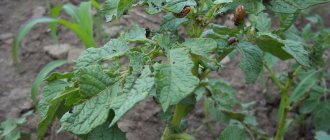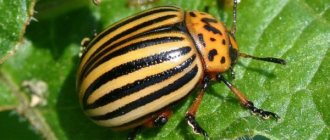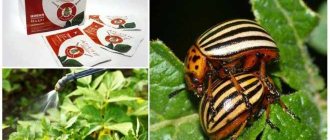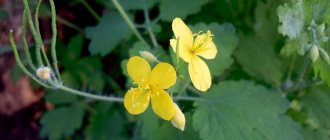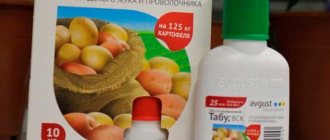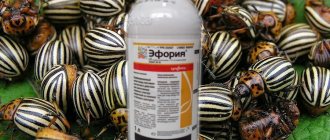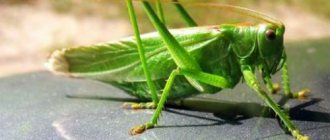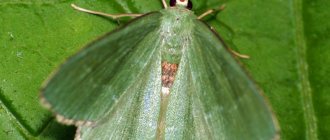Why was the beetle called the Colorado potato beetle?
First of all, you should consider the origin of the Colorado potato beetle. It belongs to the leaf beetles. The first representatives of the insect arrived in Europe on ships along with cargo. But then, due to their small numbers, they were immediately destroyed. And only in 1918 they were able to densely populate one of the regions of France. Taking advantage of warm periods, beetle colonies spread eastward.
The name of the insect comes from the state of Colorado, where it was spotted. Then, in 1859, there was an invasion of beetles, which led to the destruction of the greenery of all potato fields.
There is an opinion that the name of the beetle comes from its appearance. This is explained by the fact that the word “Colorado” is translated as colored.
Colorado potato beetle in a dream
So, why do you dream about the Colorado potato beetle? In fact, these characters don't have clear interpretations or events that they could foreshadow, so it all depends on the individual. If he still managed to dream, all that remains is to reproduce the details of the dream and draw a conclusion on his own. Bugs usually portend trouble for you or those around you.
- For a woman - treason and betrayal;
- For a man - difficulties with finances;
- For a girl – shopping or meeting with friends;
- For a child it is a festive event.
If you dreamed about a Colorado potato beetle, the modern dream book interprets events depending on the behavior of the pest.
- Crawling over your body - you will have an enemy in life.
- Creeping before your eyes - big troubles.
- There are a lot of parasites that have filled the review - a lot of small problems.
- Collecting Colorado potato beetles is a major financial investment.
So, we looked at what the Colorado potato beetle is, and how it affects potatoes, and got acquainted with the peculiarities of its life activity and reproduction.
How to recognize an insect
You can understand where the Colorado potato beetle lives by its taste preferences. Both the adult and the larva eat potato leaves, while at the same time, in the absence of such, the greens of eggplant, tomatoes and peppers are used. The insect's appetite is simply enormous.
Larvae eat potato leaves
In addition, it reproduces very quickly. The insect easily adapts to any chemicals. All this explains the prevalence of the Colorado potato beetle and the volume of losses from its activities.
The size of the insect does not exceed 12 mm. The width of the body is 7 mm. An adult beetle is yellow in color with a pronounced shine to the shell. It has black stripes and spots.
The wings of the Colorado potato beetle are especially well developed, which allows it to fly over long distances.
Read on topic:
Features of the life activity of ladybugs
14.11.2020
Description of chironomids and their possible danger to humans
14.11.2020
What do cutworms look like and what harm do they cause?
14.11.2020
What do goliath beetles look like and can they be bred at home?
14.11.2020
The larva does not exceed 15 mm in length. Her head is always black, but her body changes depending on her age. Initially it is brown, then as it matures it becomes yellow and by the adult stage it acquires an orange color. The sides are decorated with black dots.
From the history
The homeland of the Colorado potato beetle is the country of eternal summer, Mexico. It was there that he was first encountered in 1824. The insect, which was unremarkable at that time, fed on the leaves of tomato, eggplant and pepper, and less often on the leaves of petunia and tobacco.
During the period of the spread of a new crop in the United States - potatoes, a small pest tried it too. Since then, potatoes have become his main favorite dish, both in spring and summer.
In Colorado in 1959, an insect caused enormous damage to fields planted with potatoes. Therefore, the name “Colorado beetle” was assigned to it. After this incident, the history of the Colorado potato beetle began to conquer other territories.
Thanks to the development of shipping in 1876, the bug successfully crossed the Atlantic Ocean to Germany, where it was first discovered in the vicinity of Leipzig. Now people knew what the Colorado potato beetle looked like and the dangers of its presence in the fields. Initially, insect outbreaks were closely monitored, measures were taken and their further spread was prevented.
The First World War pushed the task of fighting insects into the background. I had to forget for a while about how the Colorado potato beetle harms plants. This contributed to the further victorious march of insatiable pests towards Europe. The French town of Bordeaux, where the American military base was located, became a “window” to Europe. It was here that food supplies from the United States, including potatoes, arrived. From this point the spread of insects began in France, which then could not be stopped.
When the Colorado potato beetle appeared in Russia, few people were ready to meet it.
The insect came to the USSR after the end of the Second World War. In 1949, it was found in Ukraine; in 1953, places of accumulation of leaf beetles were recorded simultaneously in the vicinity of Kaliningrad and Brest, in the Grodno and Volyn regions. Thanks to the dry and warm summer of 1958, orders of insects spread at lightning speed to Ukraine, Belarus and the Baltic states. The area where the Colorado potato beetle came from in Russia is now difficult to accurately determine. According to one version, it was brought in 1975 from Ukraine to the Southern Urals in wagons with straw. Since then, its population has increased and settled throughout Russia.
How does a beetle eat
As already mentioned, the insect is extremely voracious. In addition to cultivated plantings, they perfectly eat henbane and wolfberry leaves. Also sometimes insects are found on petunia and tobacco plantings.
Beetles only eat greens. They will not feast on either the fruits or the underground part of the planting.
The insect's appetite is especially pronounced in the larval stage. If no measures are taken to remove uninvited guests, a flock of caterpillars can completely destroy the plantings. Moreover, they eat the leaves along with a clutch of their own eggs. After the bush is left without a single leaf, the caterpillars fall off it and begin to destroy the young potato shoots located above the very surface of the soil.
Beetles only eat the top green part of the potato bush
How does an insect develop?
During frosts, beetles lie down in the soil to a depth of half a meter. With the first thaw, they begin to emerge from their hiding places. This period can even take a month, since they move slowly, and temperature fluctuations also affect them.
In total, the development of the Colorado potato beetle includes four stages:
- Eggs. They are deposited in huge quantities, up to a thousand pieces. Placed on potato leaves. The shape of the eggs is oblong, up to 1.8 mm long. The egg stage lasts up to 17 days, depending on climatic conditions. In this case, the color of the masonry may change.
- Larva. After emerging from the egg, she must also molt four times. At the first stage, the caterpillar is gray, up to 2.5 mm long. The insect is covered with hairs. Already from the first stage, the larva begins to devour greens. After molting in the second stage, the larva becomes red in color and grows to 4.5 mm in length. The next moult turns the insect yellow, its length increases to 9 mm. At the same time, it is completely smooth, without hairs. After the fourth moult, the caterpillar becomes orange, up to 16 mm long.
- Doll. After reaching the adult stage, the larva descends along the plant and goes into the soil. This is where the pupation process takes place. It lasts up to three weeks.
- Bug. It emerges from the pupa and immediately goes to the greenery to feed. The color of the insect is orange. The shell is soft, but after a few hours it gains strength, and the color changes to its usual: yellow with black stripes and dots.
The beetle lays eggs, from which the larvae hatch.
The beetle has no other subspecies, so the duration of the stages is strictly observed for all its representatives.
Colorado potato beetle: a war that humanity ingloriously lost
...Once upon a time there was a beetle. An ordinary leaf beetle, unremarkable except for its beautiful striped “suit”. He lived among the mountain spurs in northern Mexico, ate wild nightshade and in the harsh climate did not reproduce much, and therefore did not bother anyone
As time went. For hundreds and thousands of years, nightshade seeds were carried by birds, animals and people, and following the plants, the beetle moved further and further north until it reached the Rocky Mountains. Over the past time, Columbus managed to discover America, and then settlers flocked to the New World. To feed themselves and their families, people engaged in agriculture, growing wheat, rye, corn and potatoes, which were first brought to Spain in the 16th century, and gradually came close to the Rocky Mountains, where the historical meeting took place.
The potatoes grown by the settlers were no longer the wild potatoes with small, watery tubers that once grew on the American continent - they were replaced by human-bred varieties with large, tasty tubers. Wild nightshade grew in potato fields like a weed, and since they were close relatives with potatoes, the beetle quickly figured out the benefits of the new food and switched to juicy, tender potato leaves. The nightshade leaf beetle received an abundance of food and, in new conditions, began to reproduce at an unprecedented speed.
At the beginning of the 19th century, naturalist Thomas Say found yellow beetles unknown to science with longitudinal black stripes on the back on wild nightshade bushes, described it as a new species and gave the beetle the name “ten-striped leaf beetle.” Then this discovery interested a dozen or two entomologists, no more. The Spanish conquistadors brought to Europe not only Inca gold, but also the first leaf beetles. True, the lack of food supply at that time left no chance for the “settlers.” The first SOS signal for this beetle sounded loudly in 1855 in Nebraska, when the leaf beetle was named a dangerous pest. However, what the beetle did then could not be compared with the events of 1859 in Colorado, where the beetle completely devastated potato fields. Since then it has been called “Colorado”.
People had no idea how to deal with this invasion. All that was known about the beetle was that it feeds on potatoes; there were no insecticides. We tried to collect the pests with our hands, but given the rate of reproduction of the beetle, this turned out to be unproductive. In many places, they stopped growing potatoes altogether, and the Colorado potato beetle, meanwhile, was now moving east - both with the help of its wings and along with passing cargo, until it reached the shore of the Atlantic Ocean. North America fell under the onslaught of hordes of pests, potato fields were destroyed all around, farmers suffered catastrophic losses. These events were watched with alarm in Europe; some countries completely refused to import American potatoes. Cargo arriving from overseas was subject to thorough inspection, and any beetles found were immediately destroyed. Several times the Colorado potato beetle managed to get into the fields, but thanks to the small area of infected areas, as well as a life-and-death fight against the pest by burning potato plantings with the involvement of the army, for the time being, the beetle was managed.
Alas, around 1916-1918, in the port of Bordeaux, Colorado beetles flew from the side of the ship to the shore. The First World War was going on, people were busy with other problems. In addition, grapes were traditionally grown in this part of France; there were few potato plantings. In fact, for three years the uninvited guest quietly rampaged through the fields, until one of the peasants, enraged by the loss of the entire potato harvest, collected beetles from his own field and sent them to the Paris Academy of Sciences. The scientists grabbed their heads, but time was hopelessly lost: neither flamethrowers nor poisons helped, the Colorado potato beetle had spread over too large a space.
All measures to combat the Colorado potato beetle provided only a temporary respite and somewhat slowed down the further spread of the beetle. Having gained a foothold in the European bridgehead, the Colorado potato beetle invaded more and more countries every year, and by the beginning of World War II, when there was no time for beetles again, it came close to the borders of the USSR. On the territory of the USSR, the first appearance of the Colorado potato beetle was recorded in 1949 in the Lvov region, where the beetle “moved” from neighboring Poland. However, thanks to the vigilance of agronomists, this “landing force” was destroyed at that time.
New foci of infection arose periodically, and they were also able to localize and eliminate the pest. But the situation was again not in favor of humans: in 1958, a huge number of Colorado beetles from Hungary, Czechoslovakia and Poland flew to the Transcarpathian region, where they quickly settled not only on the plains, but also in the mountainous regions. A year later, a similar situation arose in Belarus, Lithuania and the Kaliningrad region, and in 1960 - in Moldova. The Colorado potato beetle again won not by skill, but by numbers, conquered the main potato growing areas and reached Kuban...
In 1975, the Colorado potato beetle was already found in the Southern Urals region, and by the 2000s this Mexican “macho” had reached Primorye! So, in one and a half hundred years, this centimeter-long pest practically conquered two continents, putting the large and smart Homo Sapiens on both shoulder blades...
The appearance of the Colorado potato beetle is quite striking and memorable: with medium size (8-12 mm), it has a strongly convex dorsal body of a bright yellow-orange color, there are black spots on the pronotum, and on each elytra there are five black longitudinal stripes . Colorado beetles have well-developed membranous wings, which allows them to fly long distances.
During the wintering period, adult insects burrow into the soil to a depth of 50 cm. In the spring, as soon as the soil warms up sufficiently, they climb to the surface and begin to sweep away potato seedlings, simultaneously mating and laying eggs on the lower surface of the leaves. During the season, one female can lay up to 1,000 eggs. After 5-17 days, depending on weather conditions, the eggs hatch into larvae, initially about 1.5 mm long and growing to 1.5 cm, orange in color with a black head and black dots in two rows on the sides of the body. During development, each larva experiences four molts and constantly eats. After two to three weeks, the larva burrows into the soil and pupates, and the adult beetle that hatches from the pupa either comes to the surface or overwinters in the soil until next spring.
During a season, in areas with a warm climate, two or three generations of the Colorado potato beetle can change. Typically, the lifespan of an adult insect rarely exceeds a year, but it is known that individual Colorado potato beetles can live for 2-3 years. The unique property of these insects is to hibernate under unfavorable circumstances and wait for more suitable times, which makes it very difficult to combat them. When in danger, the Colorado potato beetle falls to the ground like a stone and pretends to be dead. On hot summer days or before wintering, Colorado beetles organize mass flights tens of kilometers from their previous habitat.
In the victorious march of the Colorado potato beetle through the countries of the Old World, a huge role was played by the almost complete absence of natural enemies here. By feeding on plants of the nightshade family, they accumulate the poisonous alkaloid solanine, so some birds of the pheasant family, as well as lacewings and ground beetles among insects, can eat beetle larvae without harm to themselves. Guinea fowl can feed on adult beetles; turkeys are taught this from an early age. Colorado beetles quickly get used to many poisons; manual collection of adult beetles and larvae is not able to compete with the speed of their reproduction.
Attempts have been made to reduce the number of Colorado potato beetles using certain species of predatory bugs, the larvae of which eat clutches of eggs. However, as soon as the number of these bugs in the area decreases, the Colorado potato beetle immediately restores its population. Experiments were also carried out on breeding insects - analogues of the natural enemies of the Colorado potato beetle on the American continent, but adapted to life in a more severe climate, or crossing the Colorado potato beetle with other species to change the “nutrient base”. Alas, no particular success has been achieved in this field.
A certain shift in the effectiveness of the fight against the Colorado potato beetle emerged with the development of genetic engineering, when scientists introduced individual genes of some bacteria into the potato genome. However, the Colorado potato beetle demonstrated its “unsinkability” here too, eventually getting used to such varieties. There are certain varieties of potatoes that, while not GMO, are simply not to the taste of the Colorado potato beetle due to their hard leaves and high content of certain substances (for example, tomatine). Plantings of such potatoes are significantly less affected by beetles.
The Colorado potato beetle is sensitive to odors: it does not like proximity to borage, calendula, legumes, and garlic. Spraying potatoes with an infusion of wormwood, celandine, dandelion, and onion peel helps to repel the Colorado potato beetle. Potato bushes and row spacing are sprinkled with a mixture of pine and birch sawdust and pollinated with ash (up to 10 kg of ash per hundred square meters). Colorado potato beetle larvae die when potatoes are sprayed with a urea solution (100 g per 10 liters of water).
One of the old ways to combat the Colorado potato beetle is to pour ash and onion peels into the hole when planting potato tubers. As practice shows, for greater efficiency it is better to use several methods of combating the beetle at the same time. Be that as it may, so far humanity is losing the battle with the Colorado potato beetle completely. In Hungary there is even a monument to the Colorado potato beetle, erected for its resilience and ability to adapt:
We can only hope that some bright mind will emerge and solve this problem radically.
www.myjane.ru/
Are all bugs dangerous?
The potato beetle has no varieties, so if you notice an insect on a bush that is slightly different from the one described, you need to think about it. The fact is that there is a false potato bug. It can be distinguished by the lighter tone of its body. Moreover, it has white rather than black stripes.
It may be on potato leaves, but it does not use them for food or reproduce near it. The false beetle prefers nightshades, but only for weeds.
Insect spread
Despite its exotic name, the animal is distributed almost all over the world. The exceptions will be the Far North and desert zones.
Since 1855, beetles have systematically caused damage to farmers in Mexico and North America. At the end of the 19th century, the beetle made itself known in Europe, and by the middle of the last century it had spread throughout almost its entire central and western part.
In the European half of the USSR, the Colorado invasion was first encountered in the 50s of the 20th century. In the 70s, the beetle reached the Urals. And at the beginning of the 21st century - to the Primorsky Territory.
How dangerous is the potato leaf beetle?
By studying the characteristics of the insect, you can easily understand where the Colorado potato beetle lives. As a rule, it can be found in cultivated fields planted with potatoes, as well as in vegetable gardens. They eagerly devour the greens of tomatoes, peppers, eggplants, as well as some flowers.
This video will help you get rid of the Colorado potato beetle:
Initially, the insect devours the lower part of the leaf. Then he moves higher until all the leaves are eaten. Having finished with one bush, the beetle and the larva move to the next one. Until the hibernating beetle or larva from the pupa emerges from the soil, they can feed on potato tubers along the way.
If there are no plantings on the site that interest the beetle, they can fly very long distances in search of more favorable conditions.
In extreme heat, insect activity decreases slightly. They can go into a kind of hibernation for several days.
Appearance and features
Photo: Colorado potato beetle in nature
The Colorado potato beetle is a fairly large insect. Adults can grow up to 8 - 12 mm in length and approximately 7 mm in width. The body shape of the beetles is somewhat reminiscent of a water drop: oblong, flat at the bottom and convex at the top. An adult beetle can weigh 140-160 mg.
The surface of the beetle's body is hard and slightly shiny. In this case, the back is yellowish-black with black longitudinal stripes, and the belly is light orange. The beetle's black oblong eyes are located on the sides of its round and wide head. On the head of the beetle there is a black spot similar to a triangle, as well as movable, articulated antennae, consisting of 11 parts.
The hard and fairly durable elytra of the potato beetle fit tightly to the body and usually have a yellowish-orange, less often yellow, color, with longitudinal stripes. The wings of the Colorado potato beetle are membranous, well developed, and very strong, which allows the beetle to travel long distances in search of sources of food. Female beetles are usually slightly smaller than males and do not differ from them in any other way in appearance.
How to get rid of a beetle
If you do not fight the beetle, its numbers will grow every year. The larvae will destroy all plantings, leaving owners without a harvest. The safest method is to manually collect the larvae and beetles and then destroy them. But this method is suitable for small areas.
The biological control method is also relatively safe. These are drugs that contain fungi or viruses. You can also use traps that are installed in large numbers throughout the garden. But still the most powerful, but not always safe, method is the chemical method. It includes the use of the following drugs:
- Bankol. All planted greenery should be treated with a solution prepared at the rate of 5-7 grams of powder per 10 liters of water. This volume is designed for 100 m2.
One of the popular remedies for bugs is Prestige
- Prestige. Product with low toxicity. Promotes not only the destruction of larvae, but also improves the germination of shoots. In addition, the drug increases the resistance of plants to negative factors. Treatment is carried out every 40 days.
- Akarin. It is used not only against beetles, but also in the fight against other pests. A 4 ml bottle holds 20 liters of water.
There are also traditional methods of control, but given the insect’s ability to adapt to any negative factors, it is better to immediately use a powerful remedy. By using it correctly, toxic effects on humans can be avoided.
Colorado potato beetle larva and its weaknesses
Despite the fact that today there are dozens or even hundreds of different ways to get rid of the above insects, folk remedies are still quite popular. They are also characterized by their diversity. The most important thing is that each person has the opportunity to choose the most optimal way to combat the Colorado potato beetle for a particular case.
A very effective method is to plant sprouted tubers. This must be done in early spring immediately after the bud ripens.
You can also place bait on its surface in the form of cut potatoes, which will definitely attract the attention of pests. Once the beetles gather on these baits, they can be destroyed quite simply
First of all, this concerns larvae, because without using traps it is quite difficult to determine how many of them are in the garden at one time or another.
After the future potato crop has sprouted for the first time, it must be covered with soil. This method of combating the Colorado potato beetle is also quite effective. It is best to use it around May-June. Manual collection of larvae will help if the expected harvest is far from the most impressive.
Biological control method
Practice shows that due to the correct use of this method, the larva of the Colorado potato beetle is not capable of further development and dies before the moment when it turns into a full-fledged adult. The main advantage of the biological method is that it is absolutely incapable of disturbing the ecological balance in plants and soil. In parallel with the destruction of pests, the environment is not contaminated with toxic substances, which is a very important factor for most citizens.
One of the most common biological methods of controlling Colorado potato beetles is the activation of beneficial entomofauna. In this case, you can use special preparations that were produced on the basis of very active strains of fungi and bacteria. The subsequent use of a variety of preventive methods, which absolutely do not include chemicals, allows you to protect your own vegetable crops from parasites for a long time.
Reasons for the survivability of the Colorado potato beetle
Many have noticed that the presented insect, as well as its larvae in our area, are able to tolerate the effects of a wide variety of drugs and continue to harm vegetables. In fact, this is due to a number of objective factors. Each larva of the Colorado potato beetle gets a unique opportunity to develop calmly, because it has virtually no natural enemies. The same situation is almost impossible to imagine, for example, overseas, where these insects are constantly forced to fight for their existence.
Among other things, the Colorado potato beetle has the unique ability to enter a fairly long diapause, which can last up to three years. Thanks to this opinion, this parasite survives the most difficult years of its existence without any problems, when there is a lack of food variety. After diapause is completed, the pest is still able to produce one hundred percent healthy offspring. In the winter season, it is completely useless to fight this insect. Due to the fact that Colorado potato beetles lie quite deep in the soil during this period, even strong chemicals are not capable of causing significant harm to them. If there are no beetles in the garden at a certain moment, then you should not relax too seriously. These parasites are capable of flying over distances of tens of kilometers, which is why they can settle in a new area at any time.
How else can you fight the beetle?
Today, breeders are trying to create varieties that are as resistant to any negative factors as possible. The same applies to the potato beetle. To avoid having to collect the larvae by hand or treat them with dangerous chemicals, it is enough to plant root crops that are resistant to insects.
As a rule, these are plants with dense, rough leaves covered with hairs. At the slightest damage to the shoots, the plant quickly regenerates without consequences for yield. For this purpose, the following varieties are used:
- Bryansk potatoes. It is distinguished by a high level of productivity, tastes good, and lasts well in the winter. The pulp of the tubers is dense and juicy.
There are separate potato varieties that are more resistant to Colorado potato beetles.
- Glow. The tubers are red in color, dense, high-yielding, the eyes on the tubers are small and located in small quantities.
- Kamensky. Large fruits are very pleasant to the taste. The greenery of the bush is tough, so the larvae do not eat it.
- Lasunok. White tubers, smooth, with a small number of eyes. Ripens later than other varieties.
Each owner decides for himself which type of wrestling to choose. But we can say with confidence: you need to fight the beetle and find it in time during plantings. This will preserve your harvest and reduce the likelihood of uninvited guests next year.
Natural enemies
A good option is to attract animals to your site that feed directly on the Colorado potato beetle and its larvae. These are the following individuals:
- Podusus and perillus bugs.
- Flies of the genus dorifophaga that lay their eggs in beetle larvae. Unfortunately, they are not found in Russian open spaces.
- Lacewings, ladybugs, ground beetles.
- Birds - pheasant, guinea fowl.
The Colorado potato beetle is quite a big problem for gardeners and farmers. Both its larvae and adults cause great damage to the crop. However, a number of effective and diverse methods of pest control are currently used.

